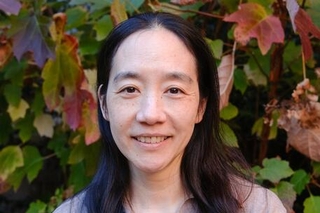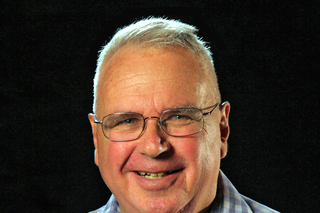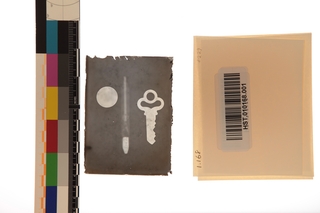
Part of set of X-Ray plates by Bumstead. Contact paper reversal of original glass plate, made 6 Oct. 1962 by Daniel D. Wheeler.
Yale Wright Lab can trace its history back to the beginning of the twentieth century when Yale scientists, including Henry Bumstead and Bertram Boltwood, became interested in the newly discovered x-rays. The Sloane Physics Laboratory became an active place for faculty, students, and visiting scientists to discuss the nature and effects of radioactivity.
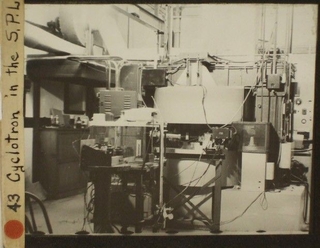
Lantern Slide: photograph of cyclotron in Sloane Physics Laboratory (SPL) at Yale. Image from Yale Peabody Museum HST collection.
1920s & 1930s
In the 1920s, Ernest Lawrence—first a graduate student, and then instructor at Yale—explored photoelectricity, which laid the grounds for his invention of the cyclotron—the first particle accelerator ever invented. Lawrence fully realized the invention a few years later, while at the University of California, Berkeley. Ernest Pollard and Howard Schultz built a version of Lawrence’s cyclotron at Yale in the 1930s.

Photograph of Pierson Sage Plaza, taken in 1954. EAL is to the right, designated the Yale Atomic Research Lab.
1940s
The Electron Linear Accelerator (EAL) was built at Yale by Howard Schultz and Carol Montgomery at the “Yale Atomic Research Lab,” which is part of the current site of Wright Lab.
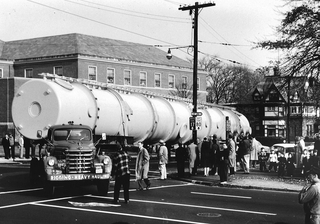
HILAC tank on a truck at the intersection of Edwards St. and Whitney Ave., New Haven—on its way to be installed.
1950s
A heavy ion linear accelerator (HILAC) was designed and built at Yale in the 1950’s by Robert Beringer and others, with physics results starting in 1958.
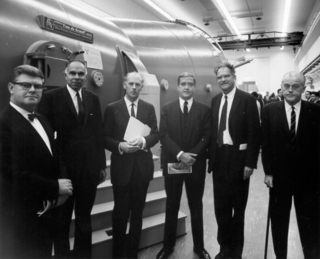
Photograph from the dedication of WNSL in 1966.
1960s
In 1961, D. Allan Bromley initiated the design of the first of ten MP tandem van de Graff electrostatic accelerators built in North America and Europe (MP-1, also known as the “Emperor”). Construction of the A. W. Wright Nuclear Structure Laboratory (WNSL) and MP-1 began in 1964. WNSL was dedicated on October 5, 1966.
With MP-1, acceleration of ions over much of the nuclear chart to energies exceeding the Coulomb barrier became possible and enabled, for the first time, the study of a broad range of medium-mass and heavy nuclei. This launched the still flourishing era of heavy ion physics and inspired the installation of similar tandem accelerators worldwide.
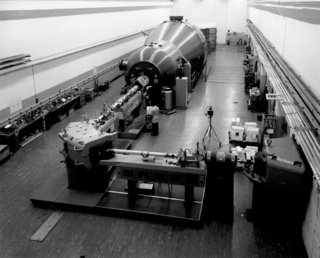
The Yale Emperor (MP-1) tandem van de Graff accelerator tank installed at WNSL.
1970s
The performance of MP-1 was upgraded through installation of new stainless steel acceleration tubes.
Over several decades, research at WNSL made important contributions to nuclear structure, including the discovery of nuclear quantum phase transitions—elegantly and successfully modeled by Wright Lab’s Francesco Iachello—to nuclear astrophysics, and to interdisciplinary fields such as nuclear geophysics. Wright Lab’s tandem accelerator facilities were particularly well suited for this role because of the combination of the flexibility of its external ion sources (as a tandem) and its emphasis on achieving higher voltage central terminals in each succeeding generation of the accelerator.

WNSL researchers and technicians inside the ESTU tank in the summer of 1988. Image courtesy of Anthony Deckoff.
1980s
The Yale MP-1 accelerator was upgraded from 1985-88, under the direction of D. Allan Bromley, to become the Extended Stretched TransUranium (ESTU) tandem accelerator. The ESTU-1 accelerator facility was dedicated on August 7, 1987.
The conversion made the ESTU the most powerful stand-alone tandem accelerator in the world until the end of its operation in 2011. The research at today’s new facilities for the study of exotic unstable nuclei is an outgrowth of earlier studies with these advanced tandem accelerators, and relativistic heavy ion accelerators have a parentage in machines like Yale’s tandem.
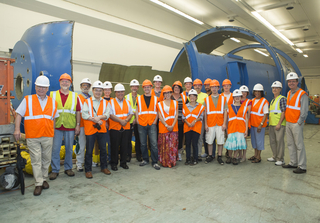
Group of Wright Lab researchers and technicians standing in front of a partially deconstructed accelerator tank.
2011-2016
With the accelerator equipment aging, and new opportunities in physics becoming available due to advances in technology, Yale ended the operation of the ESTU tandem in 2011 to enable pursuit of the frontiers of fundamental science. Karsten Heeger became director in 2013 to decommission the ESTU and begin the transformation of both the facility and the research program into what it is today.
Entrance of Wright Lab in 2018.
2017
The transformed Wright Lab officially opened on May 16, 2017 as a hub for fundamental physics, instrumentation development, and training the next generation of scientists. Wright Lab now supports a broad program in experimental nuclear physics, particle physics, and astrophysics, with particular emphasis on instrumentation development and quantum sensing for fundamental science. Wright Lab houses state-of-the-art technical facilities and a vibrant community of over one hundred scientists, students, and postdocs. It also supports the collaboration and work of Yale scientists on six continents.
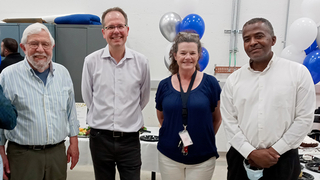
Three of the WSNL/Wright Lab directors with Paula Farnsworth, who has administratively supported them all, at the celebration.
2022
Wright Lab marked its five-year anniversary in May 2022. To learn more about what the transformed Wright Lab accomplished in its first five years, please see our 5-year (2017-22) report.

Yale leaders and state and local officials commemorate the groundbreaking. WL Director Karsten Heeger is third from the right. Photo by Dan Renzetti.
2024
Construction activities for the Upper Science Hill Development program began in June 2024. The program includes an addition to Wright Lab (WLA), a new Advanced Instrumentation Development Center (AIDC) connecting research instrumentation efforts across the University, and a new, 320,000-square-foot Physical Sciences and Engineering Building (PSEB). Construction is expected to be completed in 2030.
Arthur W. Wright
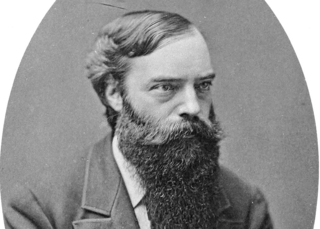
Arthur Williams Wright, for whom the Yale Wright Laboratory is named, held the first Ph.D. in science awarded in the Americas. His doctoral dissertation–on satellite mechanics–was one of three accepted by Yale University for the degree in 1861. From 1863 to 1868, Wright taught Latin and then Physics at Yale, returning in 1872 as Professor of Molecular Physics and Chemistry (later changed to Experimental Physics) until his death, in New Haven, in 1915.
Dr. Wright pioneered in many different areas of research in physics and astronomy. He developed the glow discharge preparation of reflecting optics and used these extensively in the first studies of polarization of the solar corona. He first discovered the occurrence of gases in stony meteorites and subjected them to extensive chemical and spectroscopic investigation. Immediately following the discovery of X-radiation, he was the first American to produce and the first to utilize this radiation in his analytic studies.
D. Allan Bromley
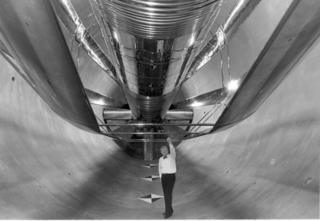
Known as “the father of modern heavy ion physics,” D. Allan Bromley significantly impacted the development of nuclear physics in the past century and became a leading figure in science policy. Bromley initiated the concept of the first WNSL accelerator in 1962, succeeded in resolving the technical issues associated with high voltage terminals, upgraded the accelerator in the mid-1980s, and led its physics program as Director of WNSL for more than 20 years.
Bromley also extended his influence nationally and internationally as the first Cabinet-level Assistant to the President of the U.S. for Science and Technology and Director of the White House Office of Science and Technology Policy from 1989-1993. He was the first Sterling Professor of Sciences at Yale and was awarded the APS Dwight Nicholson Medal for “his roles as a research scientist, an outstanding teacher, a supportive mentor and colleague, a leader of the physics community in this country and worldwide, and advisor to governments”
Directors
| Name | Years Served |
|---|---|
| D. Allan Bromley | 1961-1989 |
| Peter Parker | 1989-1995 |
| Francesco Iachello | 1995 |
| Rick Casten | 1995-2008 |
| John W. Harris | 2008-2010 |
| O. Keith Baker | 2010-2013 |
| Karsten Heeger | 2013-present |
Discover More
History News
-
A story of physics at Yale
Eun-Joo Ahn—lecturer in physics, astrophysicist, and historian of science—presented “A Story of Physics at Yale” at the October 27 Physics Club.
-
Ahn uncovers history of physics as Yale Presidential Visiting Fellow
Wright Lab’s Eun-Joo Ahn, lecturer in physics and 2023-24 Yale Presidential Visiting Fellow is an astrophysicist and historian of science.
-
Casten featured in AIP Oral History Interview
Wright Lab’s Richard Casten, professor Emeritus of physics, was interviewed by David Zierler for the AIP Oral History Interviews.

